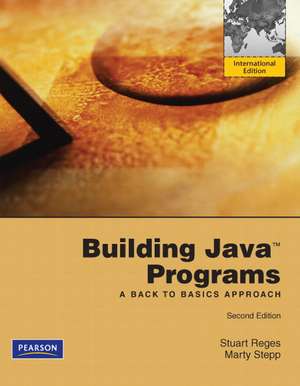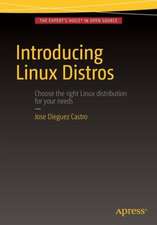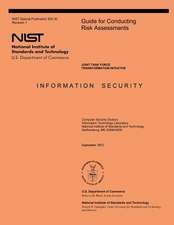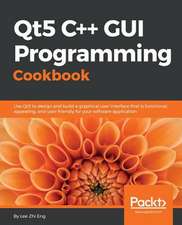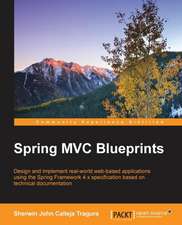Building Java Programs
Autor Stuart Reges, Marty Steppen Limba Engleză Mixed media product – 19 feb 2010
| Toate formatele și edițiile | Preț | Express |
|---|---|---|
| Paperback (1) | 506.29 lei 3-5 săpt. | +66.19 lei 4-10 zile |
| Pearson Education – 7 apr 2017 | 506.29 lei 3-5 săpt. | +66.19 lei 4-10 zile |
| Mixed media product (1) | 446.14 lei 17-23 zile | |
| Pearson Education (US) – 19 feb 2010 | 446.14 lei 17-23 zile |
Preț: 446.14 lei
Preț vechi: 557.68 lei
-20% Nou
Puncte Express: 669
Preț estimativ în valută:
75.34€ • 78.36$ • 62.19£
75.34€ • 78.36$ • 62.19£
Comandă specială
Livrare economică 20-26 martie
Preluare comenzi: 021 569.72.76
Specificații
ISBN-13: 9780137062904
ISBN-10: 0137062907
Pagini: 1176
Ilustrații: Illustrations
Dimensiuni: 190 x 230 x 40 mm
Greutate: 1.57 kg
Ediția:Nouă
Editura: Pearson Education (US)
Locul publicării:Upper Saddle River, United States
ISBN-10: 0137062907
Pagini: 1176
Ilustrații: Illustrations
Dimensiuni: 190 x 230 x 40 mm
Greutate: 1.57 kg
Ediția:Nouă
Editura: Pearson Education (US)
Locul publicării:Upper Saddle River, United States
Cuprins
Brief Contents
Preface iii
Chapter 1 Introduction to Java Programming 1
Chapter 2 Primitive Data and Definite Loops 61
Chapter 3 Introduction to Parameters and Objects 132
Supplement 3G Graphics (Optional) 188
Chapter 4 Conditional Execution 226
Chapter 5 Program Logic and Indefinite Loops 301
Chapter 6 File Processing 373
Chapter 7 Arrays 425
Chapter 8 Classes 500
Chapter 9 Inheritance and Interfaces 555
Chapter 10 ArrayLists 628
Chapter 11 Java Collections Framework 679
Chapter 12 Recursion 718
Chapter 13 Searching and Sorting 774
Chapter 14 Graphical User Interfaces 822
Chapter 15 Implementing a Collection Class 886
Chapter 16 Linked Lists 929
Chapter 17 Binary Trees 981
Appendix A Answers to Self-Check Problems 1035
Appendix B Java Summary 1107
Appendix C Javadoc Comments and the Java API Specification 1122
Appendix D Additional Java Syntax 1128
Index 1137
Preface iii
Chapter 1 Introduction to Java Programming 1
Chapter 2 Primitive Data and Definite Loops 61
Chapter 3 Introduction to Parameters and Objects 132
Supplement 3G Graphics (Optional) 188
Chapter 4 Conditional Execution 226
Chapter 5 Program Logic and Indefinite Loops 301
Chapter 6 File Processing 373
Chapter 7 Arrays 425
Chapter 8 Classes 500
Chapter 9 Inheritance and Interfaces 555
Chapter 10 ArrayLists 628
Chapter 11 Java Collections Framework 679
Chapter 12 Recursion 718
Chapter 13 Searching and Sorting 774
Chapter 14 Graphical User Interfaces 822
Chapter 15 Implementing a Collection Class 886
Chapter 16 Linked Lists 929
Chapter 17 Binary Trees 981
Appendix A Answers to Self-Check Problems 1035
Appendix B Java Summary 1107
Appendix C Javadoc Comments and the Java API Specification 1122
Appendix D Additional Java Syntax 1128
Index 1137
Notă biografică
Stuart Reges is a principal lecturer at the University of Washington where he teaches computer programming, programming languages, and discrete structures. He is co-author of an introductory Java programming textbook with Marty Stepp titled Building Java Programs: A Back to Basics Approach.
Marty Stepp is a computer science lecturer at the University of Washington where he teaches intro programming, web programming, and software engineering. Google highlighted his web programming resources in their Google Code for Educators initiative, and he was recently featured as the Seattle PI’s “Geek of the Week.” Stepp is the lead author of Web Programming Step by Step, with Jessica Miller and Victoria Kirst from the University of Washington. He is also co-author of Building Java Programs: A Back to Basics Approach with Stuart Reges. Stepp wrote an online tool for practicing Java problems to accompany the Java textbook, called Practice-It!. He is also first author of Computing Fundamentals with C#.
From 2004 — 2006, Stepp worked as a computer science lecturer at the University of Washington, Tacoma. Before that he spent a year as a developer at Microsoft on the Excel team. Stepp got a Master’s degree in computer science at the University of Arizona in 2003. He has done research in geometric algorithms and security, taught several courses as a graduate student, and was a teaching assistant for several years.
Marty Stepp is a computer science lecturer at the University of Washington where he teaches intro programming, web programming, and software engineering. Google highlighted his web programming resources in their Google Code for Educators initiative, and he was recently featured as the Seattle PI’s “Geek of the Week.” Stepp is the lead author of Web Programming Step by Step, with Jessica Miller and Victoria Kirst from the University of Washington. He is also co-author of Building Java Programs: A Back to Basics Approach with Stuart Reges. Stepp wrote an online tool for practicing Java problems to accompany the Java textbook, called Practice-It!. He is also first author of Computing Fundamentals with C#.
From 2004 — 2006, Stepp worked as a computer science lecturer at the University of Washington, Tacoma. Before that he spent a year as a developer at Microsoft on the Excel team. Stepp got a Master’s degree in computer science at the University of Arizona in 2003. He has done research in geometric algorithms and security, taught several courses as a graduate student, and was a teaching assistant for several years.
Caracteristici
- A back-to-basics presentation focuses on a traditional procedural approach first then builds into object-oriented programming, which allows students to learn both styles of programming.
- Detailed explanations build problem-solving skills by showing students how to apply programming constructs and common pitfalls to avoid. The text is problem-centered, and talks in detail about how to apply constructs instead of simply describing them.
- A layered organization eases students into the early chapters before expanding into in-depth discussions. Control structure coverage is spread out in the early chapters
- Case study examples at the end of each chapter illustrate how to apply concepts in a mid-sized program.
- Each new copy of the Second Edition comes with a Student Resource Disk that includes source code and Java™2 Platform Standard Edition Development Kit 5.0, Java™2 Platform Standard Edition Development Kit 6.0, DrJava IDE, and Eclipse™.
Answers for all self-check problems appear in Appendix A. Students can access the following resources at http://www.aw-bc.com/info/regesstepp/ or from the authors' web site at http://www.buildingjavaprograms.com/
- Source code and data files for all case studies and other complete program examples.
- The DrawingPanel class used in the optional graphics Supplement 3G.
- The Practice-It! web programming practice system.
- VideoNotes (instructional videos) to accompany each chapter.
Instructors can also access the following resources from the authors' web site at http://www.buildingjavaprograms.com/
- PowerPoint slides suitable for lecture.
- Solutions to exercises and programming projects, along with homework spec documents for many projects.
- Sample Exams and solution keys.
- Additional Lab Exercises and Programming Exercises with solution keys.
Caracteristici noi
- Three new chapters. The authors have created three new chapters that extend the coverage of the book, using material that they present in their second course in computer science. Chapter 15 explores the issues that arise in the course of implementing a robust and powerful collection class. Chapter 16 explores programming with linked lists, and Chapter 17 explores programming with binary trees.
- Improved case studies. Chapters 6 and 7 contain new case studies that are more interesting than those included in the first edition. The other case studies throughout the textbook have been expanded to better explain subtle points with which students often struggle.
- Reorganization of “using objects” material. Material in Chapters 3, 4, and 6 has been reorganized into a new section in Chapter 7 on “reference semantics.” The authors have found that this approach works better for explaining these important concepts.
- New section on procedural design heuristics. Chapter 4 now includes a discussion of design guidelines for procedural programming.
- New section on de Morgan’s laws. Chapter 5 has been updated to include a section on de Morgan’s laws and their application to programming with boolean expressions.
- Rebalancing of object coverage. The authors have adjusted Chapters 8 and 9, which cover objects and inheritance, to provide more coherent coverage of these topics.
- New appendix on Java language features. A new appendix describes language details not covered in the chapters such as enumerated types and packages.
- Arrays class coverage. A new section in Chapter 7 includes coverage of the utility methods available from the Arrays class.
- Expanded self-checks and programming exercises. The authors have significantly increased the number and quality of self-check exercises and programming exercises incorporating new problems in each chapter.
- New VideoNotes. These step-by-step video tutorials bring programming concepts to life and allow beginning students to see first-hand how experienced programmers solve problems.
